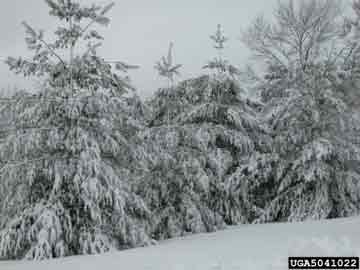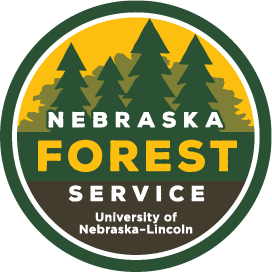The season’s first major snow storm will soon be upon us and the accompanying troublesome snowdrifts remind us that that we should have taken the time to erect snow fence in the problem areas when the weather was pleasant and the soil unfrozen. Snowdrifts in rural areas are particularly troublesome because of the miles of roads involved, and the time and money it takes to clear blocked stretches.
Create a Living Snow Fence
Slatted snow fence or similar such structural materials, when strategically placed, can effectively capture snow and prevent drifting onto susceptible areas. A more permanent and much more attractive alternative is to plant a ‘living’ snow fence that can enhance the landscape, provide food and shelter for wildlife, protect the environment, and offer a possible alternative income source....all while trapping and controlling snow-drift away from critical areas.
A living snow fence is comprised of trees and/or shrubs that becomes a protective vegetative barrier against the negative effects of wind-blown snow. This living fence can be planted as single or multiple rows and the plant species can be mixed to add color and variety to the landscape. A living snow fence with all shrubs can be a showcase of structure and color making for a beautiful addition along a road or driveway. In addition, mixed species can provide different kinds of food for birds and small game. There might be a demand in the immediate area for colorful and/or intriguing stems cut from selected mature shrubs during the early winter.
Living snow fences take a few years to establish a beneficial snow-trapping height and thickness as opposed to the instantaneous results from a slatted snow fence. However, the longevity of a snow fence can be many times greater than slats and is certainly more beneficial in terms of year-round beauty and environmental function.
A living snow fence can serve as a memorial to a family member, friend, or public servant. I’m reminded of a quarter-mile of conifers along a highway in my home county planted in memory of the landowner who was an avid conservationist. They were planted in an area that was formerly plagued with snow that drifted onto the state roadway. The planting eliminated the problem, added striking beauty to the landscape, and gave honor to one who cared.
Cost-Share Potential
A living snow fence may qualify for cost-share under the Continuous Conservation Reserve Program if planted into an area that has a previous cropping history. Check with your local county Natural Resources Conservation Service (NRCS) or Farm Service Agency (FSA) office regarding this possibility. Most Natural Resources Districts are currently taking orders for trees and shrubs for planting next spring. They offer a wide selection of conifers, deciduous, fruit, and nut trees as well as a several species of shrubs.
Plan a beautiful way to stop the snow from drifting onto nearby county roads or across your driveway by planting living material that will be will pleasing aesthetically and environmentally beneficial.

